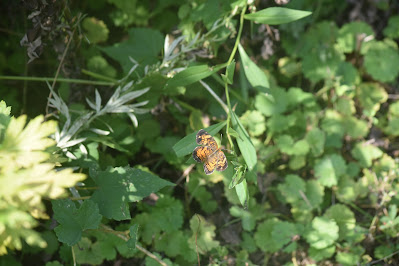Photo credit: Rick Gutleber (
link)
Yesterday, Charles Smith, a naturalist and ecologist led me and a group of other Arlington Regional Master Naturalist trainees on a walk around Dora Kelley Nature Park. He taught us about some of the native plants we were seeing along the trail, and shared some insight into what makes a healthy natural system, or a good habitat for wildlife.
- There is biodiversity of tree and plant species.
- There is a lack of invasive species.
- There is variety of tree ages (older, mature trees along with much younger trees).
- There is a year-round natural stream.
As it turns out - if you love animals, you also love dirt. Soil along with the bacteria and fungus networks in the soil are a huge part of what makes a healthy ecosystem that can support all kinds of wildlife. Trees are feeding the soil as well as taking from it - they release some of their sugars into the ground which feed bacteria and fungus systems that then benefit the trees and the whole food chain.
Charles also talked about how a disturbed ecosystem - one that has been clear-cut, flooded, fire-suppressed, or fragmented is much less able to resist the invasion of foreign species.
Some invasive plants like garlic mustard actually are allelopathic - which means they produce chemicals that prohibit the growth of other plants. This invasive species is especially problematic because it prevents other plants from growing near it.
Garlic Mustard. Photo credit: wikipedia user sannse
(link)
All invasive plants hurt biodiversity of wildlife because they aggressively take up resources but don't feed insects which would then feed birds, reptiles and mammals.
Fragmentation is another problem - human activity increasingly fragments natural areas with roads and development. Some species have evolved to only live deep inside a forest - but unfortunately they cannot survive in smaller and smaller fragments. Edge species, those generalists that do well at the edge of two types of habitats (think deer, raccoons, blue jays), proliferate in edge habitat, which has its own consequences.
Deer overpopulation inhibits biodiversity, as deer love to eat tree saplings and browse shrubs and understory vegetation, which otherwise would provide homes and food for many other species. The topic of deer population management is controversial because they are so beautiful - but when we remove the predators of a species we then are responsible for keeping populations in check ourselves. Fairfax county has a safe and effective archery program. Arlington needs to follow suit.
We also got to learn from Matt Neff, naturalist and animal keeper at the National Zoo in the
Reptile Discovery Center. He spoke to us about herpetology - the study of amphibians and reptiles, and showed us how to properly roll logs to find critters. If you do this, it is very important to roll the log back into place after you are done! The ecosystem under a log is particularly hospitable to critters because it retains moisture and provides shelter from predators and weather extremes.
Matt recommends the Salamanders of the United States and Canada field guide, Peterson's Field Guide for Reptiles and Amphibians, and the Lizards/Snakes of the Southeast (along with their other books in that series). He also suggested anyone with interest join the Virginia Herpetological Society to participate in surveys. Their
website is also very helpful for finding information.
While rolling logs, we found a worm snake! Worm snakes are fossorial, meaning they live underground, and eat earthworms. They look a bit like worms but are actually snakes.
Photo credit: Tina Dudley
It was hard to get a close up photo of his face, so for reference, this is what their face looks like:
Photo credit: Flikr user cotinis (
link)
Then we had a wonderful presentation on native plants by volunteer and ARMN member, Valerie LaTortue.
This article describes the incredible work that Valerie has accomplished in the garden, with the help of many volunteers.
While gardening in the demonstrative native garden at the Dora Kelley Nature Center, we also came across a few other exciting herps.
Photo credit: Tina Dudley
This gorgeous turtle is a box turtle. If you ever find a turtle on the road, move them to the other side of the road in the direction they were facing.
We also saw a few DeKay's brownsnakes, (below), some common skinks and even a couple Mediterranean geckos (an introduced species, not pictured).
Photo credit: Tina Dudley
Photo credit: Tina Dudley
Dora Kelley is unusual in northern Virginia, sadly, because it is a good natural system. It could be better if it had more understory plants, but it is an example of a solid, stable ecosystem.
Check out this trail guide for some interpretation of what you see on your walk. Nature center is hopefully re-opening next month, so its a lovely place to take kids. They have some lovely reptiles inside you can examine more closely, no log-rolling needed.
And wherever you live, consider planting
more natives in your yard or garden. Or at least avoid invasive plants like english ivy! Help out your local wildlife.
Sources:
Charles Smith
Matt Neff
https://www.chattnaturecenter.org/visit/experience/wildlife/animal-facts/eastern-box-turtle/






























